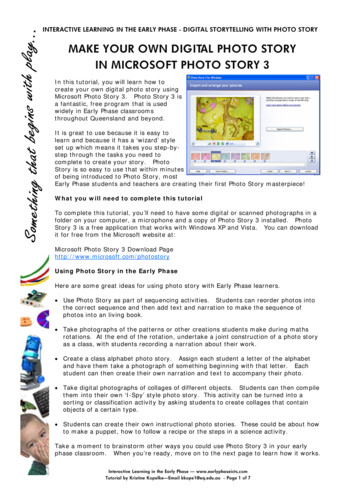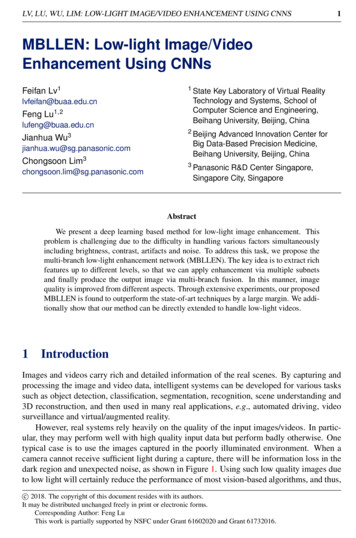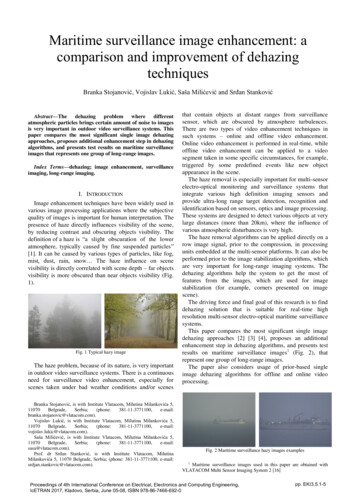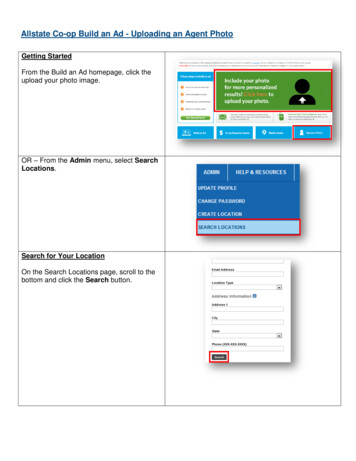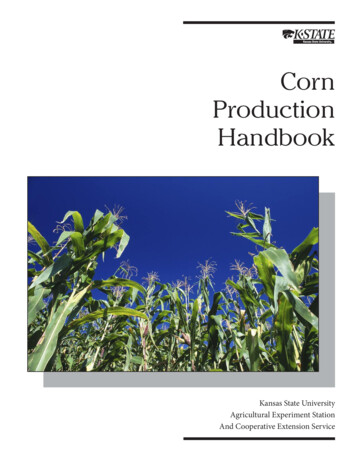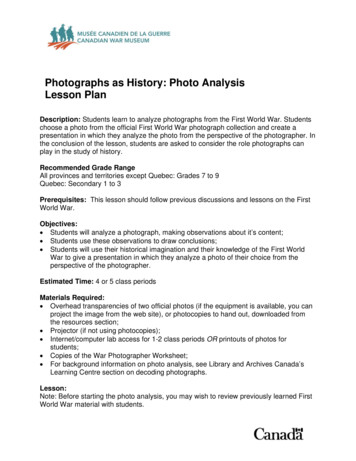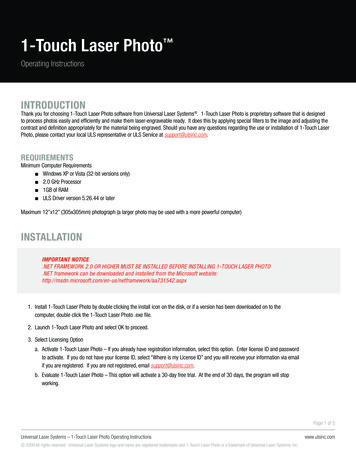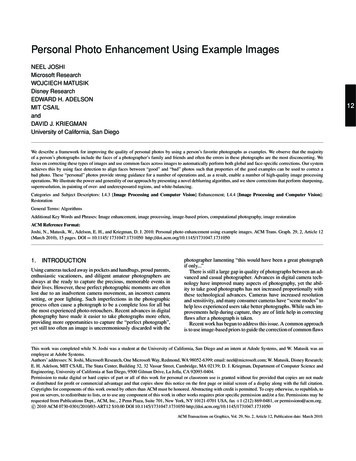
Transcription
Personal Photo Enhancement Using Example ImagesNEEL JOSHIMicrosoft ResearchWOJCIECH MATUSIKDisney ResearchEDWARD H. ADELSONMIT CSAILandDAVID J. KRIEGMANUniversity of California, San Diego12We describe a framework for improving the quality of personal photos by using a person’s favorite photographs as examples. We observe that the majorityof a person’s photographs include the faces of a photographer’s family and friends and often the errors in these photographs are the most disconcerting. Wefocus on correcting these types of images and use common faces across images to automatically perform both global and face-specific corrections. Our systemachieves this by using face detection to align faces between “good” and “bad” photos such that properties of the good examples can be used to correct abad photo. These “personal” photos provide strong guidance for a number of operations and, as a result, enable a number of high-quality image processingoperations. We illustrate the power and generality of our approach by presenting a novel deblurring algorithm, and we show corrections that perform sharpening,superresolution, in-painting of over- and underexposured regions, and white-balancing.Categories and Subject Descriptors: I.4.3 [Image Processing and Computer Vision] Enhancement; I.4.4 [Image Processing and Computer Vision]:RestorationGeneral Terms: AlgorithmsAdditional Key Words and Phrases: Image enhancement, image processing, image-based priors, computational photography, image restorationACM Reference Format:Joshi, N., Matusik, W., Adelson, E. H., and Kriegman, D. J. 2010. Personal photo enhancement using example images. ACM Trans. Graph. 29, 2, Article 12(March 2010), 15 pages. DOI 10.1145/ 1731047.1731050 UCTIONUsing cameras tucked away in pockets and handbags, proud parents,enthusiastic vacationers, and diligent amateur photographers arealways at the ready to capture the precious, memorable events intheir lives. However, these perfect photographic moments are oftenlost due to an inadvertent camera movement, an incorrect camerasetting, or poor lighting. Such imperfections in the photographicprocess often cause a photograph to be a complete loss for all butthe most experienced photo-retouchers. Recent advances in digitalphotography have made it easier to take photographs more often,providing more opportunities to capture the “perfect photograph”,yet still too often an image is unceremoniously discarded with thephotographer lamenting “this would have been a great photographif only.”There is still a large gap in quality of photographs between an advanced and casual photographer. Advances in digital camera technology have improved many aspects of photography, yet the ability to take good photographs has not increased proportionally withthese technological advances. Cameras have increased resolutionand sensitivity, and many consumer cameras have “scene modes” tohelp less experienced users take better photographs. While such improvements help during capture, they are of little help in correctingflaws after a photograph is taken.Recent work has begun to address this issue. A common approachis to use image-based priors to guide the correction of common flawsThis work was completed while N. Joshi was a student at the University of California, San Diego and an intern at Adode Systems, and W. Matusik was anemployee at Adobe Systems.Authors’ addresses: N. Joshi, Microsoft Research, One Microsoft Way, Redmond, WA 98052-6399; email: neel@microsoft.com; W. Matusik, Disney Research;E. H. Adelson, MIT CSAIL, The Stata Center, Building 32, 32 Vassar Street, Cambridge, MA 02139; D. J. Kriegman, Department of Computer Science andEngineering, University of California at San Diego, 9500 Gilman Drive, La Jolla, CA 92093-0404.Permission to make digital or hard copies of part or all of this work for personal or classroom use is granted without fee provided that copies are not madeor distributed for profit or commercial advantage and that copies show this notice on the first page or initial screen of a display along with the full citation.Copyrights for components of this work owned by others than ACM must be honored. Abstracting with credit is permitted. To copy otherwise, to republish, topost on servers, to redistribute to lists, or to use any component of this work in other works requires prior specific permission and/or a fee. Permissions may berequested from Publications Dept., ACM, Inc., 2 Penn Plaza, Suite 701, New York, NY 10121-0701 USA, fax 1 (212) 869-0481, or permissions@acm.org.c 2010 ACM 0730-0301/2010/03-ART12 10.00 DOI 10.1145/1731047.1731050 http://doi.acm.org/10.1145/1731047.1731050 ACM Transactions on Graphics, Vol. 29, No. 2, Article 12, Publication date: March 2010.
12:2 N. Joshi et al.Fig. 1. Automatically correcting personal photos. We automatically enhance images using prior examples of “good” photos of a person. Here we deblur ablurry photo of a person where the blur is unknown. Using a set of other sharp images of the same person as priors (left), we automatically solve for theunknown blur kernel and deblur the original photo (middle) to produce a sharp image (right); the recovered blur kernel is shown in the top right enlarged 3 .such as blurring [Fergus et al. 2006], lack of resolution [Freemanet al. 2002], and noise, due to lack of light [Roth and Black 2005].Work in this area tends to rely on priors derived from a large numberof images. These priors are specific to a particular domain, such asa face prior for superresolution of faces or a gradient distributionprior for natural images, but they tend to be general within thedomain, that is, they capture properties of everyone’s face or allnatural images. Such methods are promising and have shown someimpressive results; however, at times their generality limits theirquality.In this article, we take a different approach toward image correction. We note that many consumer photographs are of a personalnature, for example, holiday photographs and vacation snapshotsare mostly populated with the faces of the camera owner’s friendsand family. Flaws in these types of photos are often the most noticeable and disconcerting. In this work, we seek to improve thesetypes of photos and focus specifically on images containing faces.Our approach is to “personalize” the photographic process by usinga person’s past photos to improve future photos. By narrowing thedomain to specific, known faces we can obtain high-quality resultsand perform a broad range of operations.We implement this personalized correction paradigm as apostprocess using a small set of examples of good photos. Theoperations are designed to operate independently, so that a usercan choose to transfer any number of image properties fromthe examples to a desired photograph, while still retaining certain desired qualities of the original photo. Our methods areautomatic, and we believe this image correction paradigm ismuch more intuitive and easier to use than current image editingapplications.The primary challenges involved in developing our “personal image enhancement” framework are: (1) decomposing images suchthat a number of image enhancement operations can be performedindependently from a small number of examples, (2) definingtransfer functions so that only desired properties of the examples are transferred to an image, and (3) correcting nonface areasof images using the face and the example images as calibrationobjects. In order to accomplish this, we use an intrinsic imagedecomposition into shading, reflectance, and color layers and define transfer functions to operate on each layer. In this article,we show how to use our framework to perform the followingoperations.ACM Transactions on Graphics, Vol. 29, No. 2, Article 12, Publication date: March 2010.—Deblurring: removing blur for images when the blur function isunknown by solving for the blur of a face,—Lighting transfer and enhancement: transferring lighting colorbalance and correcting detail loss in faces due to underexposureor saturation,—Superresolution of faces: creating high-resolution sharper facesfrom low-resolution images.We integrate our system with face detection [Viola and Jones 2001]to obtain an automated system for performing the personalized enhancement tasks.To summarize, the contributions of this article are: (1) the conceptof the personal “prior”: a small, identity-specific collection of goodphotos used for correcting flawed photographs, (2) a system that realizes this concept and corrects a number of the most common flawsin consumer photographs, and (3) a novel automatic multiimage deblurring method that can deblur photographs even when the blurfunction is unknown.2.RELATED WORKDigital image enhancement dates back to the late 60’s with muchof the original work in image restoration, such as denoising anddeconvolution [Richardson 1972; Lucy 1974]. In contrast, the useof image-derived priors is a relatively recent development. Imagebased priors have been exploited for superresolution [Baker andKanade 2000; Liu et al. 2001; Freeman et al. 2002], deblurring[Fergus et al. 2006], denoising [Roth and Black 2005; Liu et al.2006; Elad and Aharon 2006], view-interpolation [Fitzgibbon et al.2005], in-painting [Levin et al. 2003], video matting [Apostoloff andFitzgibbon 2004], and fitting 3D models [Blanz and Vetter 1999].These priors range from statistical models to data-driven examplesets, such as a face prior for face hallucination, a gradient distribution prior for natural images, or an example set of high- and lowresolution image patches; they are specific to a domain, but generalwithin that domain. To the best of our knowledge, most work using image-based priors is derived from a large number of imagesthat may be general or class/object specific, but there has been verylittle work in 2D image enhancement using identity-specific priors. Most work using identity-specific information is in the realmof detection, recognition, and tracking in computer vision and faceanimation and modeling in computer graphics. In the latter realm,
Personal Photo Enhancement Using Example Imagesrecent work by Gross et al. [2005] has shown that there are significant advantages to using person-specific models over genericones.A related area of work is photomontage and image compositing[Agarwala et al. 2004; Levin et al. 2004; Rother et al. 2006]. Inthe work of Agarwala et al. [2004], user interaction is combinedwith automatic vision methods to enable users to create compositephotos that combine the best aspects of each photo in a set. Anotherrelated area of work is digital beautification. Leyvand et al. [2006]use training data for the location and size of facial features for “attractive” faces as a prior to improve the attractiveness of an inputphoto of an arbitrary person. We see our work as complementarythe work of Agarwala et al. [2004] and Leyvand et al. [2006], aswhile we all share similar goals of improving the appearance ofpeople in photographs, we focus more on overcoming photographicartifacts and do not seek to change the overall appearance of asubject.Our individual corrections use gradient-domain operations pioneered by Perez et al. [2003]. Our work also shares similarities withimage fusion methods and transfer methods [Reinhard et al. 2001;Eisemann and Durand 2004; Petschnigg et al. 2004; Agrawal et al.2005; Bae et al. 2006] in that we use similar image decompositionsand share similar goals of transferring photographic properties.Our face-specific enhancements are inspired by the facehallucination work of Liu et al. [2007]. Liu et al. [2007] use a setof generic faces as training data that are prealigned, evenly lit, andgrayscale. Where our work differs is that we use identity-specificpriors, automatic alignment, and a multilayered image decomposition that enables operating on a much wider range of images, wherethe images can vary in lighting in color, and we perform operationsin the gradient domain. These extensions enable the use of a morerealistic set of images (with varied lighting and color), improvematching, and give higher quality results. Furthermore, Liu et al.[2007] do not address in-painting and hallucinating entire missingregions, as we show in Figure 8.Our deblurring algorithm is related to the work of Fergus et al.[2006] and multiimage deblurring methods [Bascle et al. 1996; RavAcha and Peleg 2005; Yuan et al. 2007]. Fergus et al. [2006] recoverblur kernels assuming a prior on gradients on the unobserved sharpimage and in essence only assume “correspondence” between thesharp image and prior information in the loosest sense, in that theyassume the two have the same global edge content. Multi-imagedeblurring is on the other end of the spectrum. These methods usemultiple images of a scene acquired in close sequence and generallyassume strong correspondence between images. Our method residesbetween these two approaches with some similarities and severalsignificant differences.Relative to multi-image methods, we assume moderate correspondence, by using an aligned set of identity-specific images; however, we allow for variations in pose, lighting, and color. To the bestof our knowledge, deblurring using any type of face-space as aprior, let alone our proposed identity-specific one, is novel. Bothour method and Fergus et al.’s [2006] are in the general (and large)class of Expectation-Maximization (EM)-style deblurring methods.Where they differ is in the specific nature of the prior and that ourmethod is completely automatic given a set of prior images. Ferguset al.’s [2006] work, on the other hand, requires user input to select aregion of an image for computing a PSF. In our experience, this userinput is not simple, as it often requires several tries to select a goodregion and must be done for every image. Furthermore, our work iscomputationally simpler using a Maximum A Posteriori (MAP) estimation instead of variational Bayes, which leads to a ten to twentytimes speedup.3. 12:3OVERVIEWWe present several image enhancement operations enabled by having a small number of prior examples of good photos of a person.The enhancements are grouped into two categories: global imagecorrections and face-specific enhancements. Global corrections areperformed on the entire image by using the known faces as calibration objects. We perform global exposure and white-balancingand deblurring using a novel multi-image deconvolution algorithm.For faces in the image we can go beyond global correction andperform per-pixel operations that transfer desired aspects of the example images. We in-paint saturated and underexposed regions, correct lighting intensity variation, and perform face-hallucination tosharpen and super-resolve faces. Our system operates on base/detailimage decomposition [Eisemann and Durand 2004] and thereforethese operations can be performed independently. As illustrated inFigure 2, our system proceeds as follows.(1)(2)(3)(4)(5)Automatically detect faces on target images and prior images.Align and segment faces in target and prior images.Decompose images into color, texture, and lighting layers.Perform global image corrections.Perform face-specific enhancements.Step 1 outputs a set of nine feature points for each target and priorface and step 2 produces a set of prior images aligned to the targetimage with masks indicating the face on each image. Both stepsare discussed in detail in Section 6. Step 3 is discussed in the nextsection, step 4 in Section 4, and step 5 in Section 5.3.1Prior Representation and DecompositionIn this work, we derive priors from a small collection of personspecific images. In contrast with previous work using large imagecollections [Hays and Efros 2007], our goal is to use data that iseasily collected by even the most casual photographer, who may nothave access to large databases of images.Researchers have noted that the space spanned by the appearanceof faces is relatively small [Turk and Pentland 1991]. This observation has been used for numerous tasks including face recognitionand face hallucination [Liu et al. 2007]. We make the additionalobservation that the space spanned by images of a single personis significantly smaller; when examining a personal photo collection the range of photographed expressions and poses of faces isrelatively limited. Thus we believe the use of a small set of personspecific photos to be a relatively powerful source for deriving priorsfor image corrections.While expression and pose variations may be limited, lighting andcolor can vary significantly between photos. As a result, a centralpart of our framework is the use of a base/detail layer decomposition [Eisemann and Durand 2004] that we use as an approximate“intrinsic image” decompostion [Barrow and Tenenbaum 1978;Land and McCann 1971; Finlayson et al. 2004; Weiss 2001; Tappenet al. 2006]. In such as decomposition, an image is represented as aset of constituent images that capture intrinsic scene characteristicsand extrinsic lighting characteristics. Intrinsic images are an idealconstruct as they: (a) allow us to use a small set of prior images tocorrect a broad range of input images and (b) they enable modifyingimage characteristics independently.We adopt the base/detail layer decomposition used by Eisemannand Durand [2004] that makes this separation based on the Retinexassumption and uses an edge-preserving filter to decompose lightingfrom texture. We decompose an RGB image I into a set of fourimages [r, g, L , X ] , where Y R G B represents luminanceACM Transactions on Graphics, Vol. 29, No. 2, Article 12, Publication date: March 2010.
12:4 N. Joshi et al.Fig. 2. Personal image enhancement pipeline. First we use face detection to find faces in each image and align the prior images to the person in the targetphoto. The images are then decomposed into intrinsic images: color, texture, and lighting. First global image corrections are performed and then face-specificenhancements. We combine the global and face-specific results using gradient domain fusion.and r R/Y and g G/Y are red and green chromaticity. L, thelighting (or base) image, is a bilaterally filtered version of luminanceY . X , the shading image, is computed as X Y/L. For the sake ofsimplicity of terminology, for the remainder of this article, we willrefer to the (r, g) chromaticity reflectance images as “color layers,”L, the base image as the “lighting layer,” and X , the shading layer,as the “texture layer.”The layers from our example set are used for direct examplebased techniques and to derive statistical priors. To achieve this, wefollow the hybrid model of Liu et al. [2007] and perform correctionsusing both a linear eigenspace and a patch-based nonparametricapproach.obtain the image I G , and then we perform face-specific correctionsto obtain the final result I .Face-specific enhancements are performed in the gradient domainusing Poisson image editing techniques [Pérez et al. 2003], where animage is constructed from a specified 2D guidance gradient field, v,by solving a Poisson equation: I / t I div(v). Specifically,this can be formed as a simple invertible linear system: L I div(v),where L is the Laplacian matrix. We refer the reader to the paperby Perez et al. [2003] for more details on gradient-domain editing.3.2To align faces in examples to a face in the input image, we use animplementation of the automatic face detection method of Viola andJones [2001]. The detector outputs the locations of faces in an imagealong with nine facial features, the outside corner of each eye, thecenter of each eye, bridge and tip of the nose, and the left, right, andcenter of the mouth. From these features we align the faces usingan affine transformation.When performing face-specific enhancement, it is also necessaryto have a mask for the face in the input and prior images. We automatically compute these by using the feature locations to initiallycompute a rough mask labeling face and nonface areas of the image.First our system creates a “trimap” by labeling the image as foreground, background, and unknown regions. The foreground area ismarked as the pixel inside the convex hull of the nine detected features. The edge is labeled as background and the remaining pixelsare in the unknown region. We compute an alpha-matte using themethod of Levin et al. [2006] and threshold this soft-segmentationinto a mask. The threshold is 50% and we eroded the mask pixelsby ten pixels to get the final mask. An example of a mask is shownin Figure 3.In the following sections, we describe our enhancement and correction functions and how each uses our prior.Enhancement FrameworkWe create a desired processed image I with layers I [Ir , Ig , I L , I X ] from a given observed image O [Or , Og , O L , O X ]and an aligned set of prior images where one prior image isP [Pr , Pg , PL , PX ]. We automatically align the prior images P toO and compute a mask, F, for each face automatically. Alignmentand mask computation is discussed in the next section.The aligned, intrinsic prior layers are used directly for a patchbased method, and we also create eigenspaces for these layers. Fromeach aligned and cropped intrinsic prior layer we create a set of orthogonal basis vectors using SVD. We denote P as a matrix of basisvectors and P μ as the mean vector that describes a feature spacefor the examples. An example of this is shown in Figure 4. Unlikeprevious work in this area, since our set of examples is small wedo not use a subspace; our basis vectors capture all the variation inthe data, and thus we are simply using Singular-Value Decomposition (SVD) to orthogonalize the data. Thus, our “personal prior” isthe entire set of aligned layers and basis and mean vectors for eachspace.As illustrated in Figure 2, we perform image enhancement bycreating a desired image I , by first performing global corrections toACM Transactions on Graphics, Vol. 29, No. 2, Article 12, Publication date: March 2010.3.3Face Alignment and Mask Computation
Personal Photo Enhancement Using Example Images 12:5Fig. 3. Mask computation and layer decomposition. We perform our corrections on an “intrinsic image”-style decomposition of an image into color, lighting,and texture layers. This enables a small set of example images to be used to correct a broad range of input images. In addition, it allows us to modify imagecharacteristics independently. We also automatically compute a mask for the face that we use as part of our face-specific corrections.I can then be recovered by maximizing this posterior or minimizinga sum of negative log likelihoods.I argmax P(I O)(2)I argmax P(O I )P(I )(3) argmin L(O I ) L(I )(4)IIL(O I ) is the “data” term and L(I ) is the image prior. The specificform of each value is different for each correction. In our system, wecorrect for overall lighting intensity and color balance and performmultiimage deconvolution to deblur an image.4.1Fig. 4. Eigenfaces constraint. We use linear feature spaces built from analigned set of good images of a person as a constraint in our image enhancement algorithms. Here we show the eigenfaces used as a prior for thedelurring result shown in Figure 1.4.Image DeblurringWe deblur an image of a person using our personal prior as a constraint during image deconvolution. While pixel-wise alignment ofthe blurred image and the prior images is difficult, a rough alignmentis possible, as facial feature detection on down-sampled blurredimages is reliable. The feature space for texture layers from ourpersonal prior is then used to constrain the underlying sharp image during deconvolution. We rely on the variation across the priorimages to span the range of facial expressions and poses.We only consider blur parallel to the image plane and solve for ashift-invariant kernel. We model image blur as the convolution of anunknown sharp image with an unknown shift-invariant kernel plusadditive white Gaussian noise:O I K N,GLOBAL CORRECTION OPERATIONSMany aspects of a person’s facial appearance, particularly skin color,albedo, and the location of features, such as the eyes and nose,remain largely unchanged over the course of time. By leveragingtheir relative constancy, one can globally correct a number of aspectsof an image.We consider global corrections to be those that are calculated using the face area of an image and are applied to the entire image.Our global corrections use basis and mean vectors constructed fromthe example images as a prior within a Bayesian estimation framework. Our goal is to find the most likely estimate of the uncorruptedimage I given an observed image O. This is found by maximizingthe probability distribution of the posterior using Bayes’ rule, alsoknown as Maximum A Posteriori (MAP) estimation. The posteriordistribution is expressed as the probability of I given O.P(I O) P(O I )P(I )P(O)(1)(5)where N N (0, σ ).We formulate the image deconvolution problem using theBayesian framework discussed before, except that we now havetwo unknowns I and K . We continue to minimize a sum of negativelog likelihoods.2L(I, K O) L(O I, K ) L(I ) L(K )(6)Given the blur formation model (Eq. (5)), we haveL(O I, K ) O I K 2 /σ 2 .(7)which is the observed image’s lumiWe consider O nance, where the superscript F indicates that only the masked faceregion is considered (we will drop the F notation in later sectionsfor the sake of readability). The sharp image I we recover is thedeblurred luminance.The negative log likelihood term for the image prior isO XF O LF ,L(I ) λ1 L(I P , P μ ) I q ,(8)ACM Transactions on Graphics, Vol. 29, No. 2, Article 12, Publication date: March 2010.
12:6 N. Joshi et al.which maintains that the image lies close to the examples’ featurespace by penalizing distance between the image and its projectiononto the space, which is modeled by the eigenvectors and meanvector (P , P μ )). We have determined empirically that λ1 400works well.The term also includes the sparse gradient prior of Levin et al.[2007]: I q .The feature-space used in the prior is built from the examples’ texture layers times the observation’s lighting layer, that is,P i PXi O L , for each example i. This implicity assumes that theblurring process does not affect the lighting layer, that is, the prior’s,examples and the observation have the same low-frequency lighting.While this assumption may not always be true, it holds in practiceas lighting changes tend to be low frequency.To use this feature space, we define a negative log likelihood termusing a robust distance-to-feature space metric. L(I P , P μ ) ρ [P P (I P μ ) P μ ] I(9)this blur describes the camera-shake and we use the method of Levinet al. [2007] to deblur the whole image. A result from our methodis shown in Figure 1.P represents the matrix whose columns are the eigenvectors ofthe feature-space, and P is the transpose of this matrix. This termenforces that the residual between the latent image I and the robustprojection of I on to the feature-space [P , P μ ] should be minimal.ρ(.) is a robust error function described next.We use a robust norm (rather than L 2 norm) to make this projection more robust to outliers (for example, specular reflectionsand deep shadows on the target face or feature variations not wellcaptured by the examples ). For ρ(.) we use the Huber norm. 1 2r r kρ(r ) 2(10)1 2k r 2 k r kwhere ω L is a scalar value. The image prior is L(I ) L(I L P Lμ ) ρ P Lμ I L .k is estimated using the standard “median absolute deviation”heuristic. We use an Iterative Reweighed Least-Squares (IRLS) approach to minimize the error function.For the sparse gradient prior, instead of using q 0.8, as Levinet al. use, we recover the exponent by fitting a hyper-Laplacian tothe histogram of gradients of the prior images’ faces. To fit theexponent, consider that the p-norm distribution is y ce(x) p(c is a constant) , taking the log of both sides results in: log(y) log(c) plog(e(x)). If y I F and x is the probability ofdifferent gradient values (as estimated using a histogram normalizedto sum to one), p is the slope of the line fit to this data. By fittingthe exponent in this way we constrain the gradients of the sharpimage in a way that is consistent with the prior examples; in ourexperience, the recovered p is always between 0.5 and 0.6.The prior on the kernel is modeled as a sparsity prior on the valuesand a smoothness prior on the kernel, which are common priors usedduring kernel estimation. The likelihood L(K ) isL(K ) λ2 K p λ3 K 2 ,(11)where p 1.1Blind deconvolution is then performed using a multiscale, alternating minimization, where we first solve for I using an initialassumption for K (we use a 3x3 gaussian) by minimizing L(I B, K )and then use this I to solve for K by minimizing L(K B, I ). Eachsubproblem is solved using iterative reweighted least-squares.In performing debluring, we recover only the sharp image datafor the face and the kernel describing the blur for the face. If theperson in the target photograph did not move relative to the scene,1 We have found our method is relatively insensitive to the value of p as longas it is 1. p 0.8 seems to work well.ACM Transactions on Graphics, Vol. 29, No. 2, Article 12, Publication date: March 2010.4.2Exposure and Color CorrectionThe goal of this part of our framework is to adjust the overall intensity and color-balance of the target photograph such that theyare most similar to that of well-exposed, balanced prior images. Wemodel this adjustment with scaling parameters for the lighting andcolor layers.We robustly match the target face’s lighting and color to meanlighting and color vector from the prior feature-spaces. We againformulate this using the Bayesian framework and minimize a sumof negative
the primary challenges involved in developing our "personal im- age enhancement" framework are: (1) decomposing images such that a number of image enhancement operations can be performed independently from a small number of examples, (2) defining transfer functions so that only desired properties of the exam- ples are transferred to an image, and
